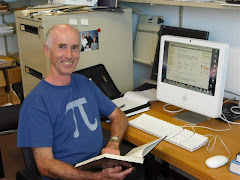
The fact that differentiation is involved should come as no surprise to senior secondary students, as we are dealing with things (e.g. temperature) changing with time and position, and motion of the air, so velocity and acceleration will be involved. To compound the fact that the motions are in three dimensions (unlike 1- dimensional kinematics), they are being observed from a rotating reference frame (the earth), giving an effective force producing curved paths (the Coriolis effect).
The convention is to use x for the eastward direction, y for the northward and z for the vertical direction, and use u, v and w respectively for the corresponding velocities in those directions.
The equation of motion of air (essentially Acceleration = Force/ mass) in the Eastward direction is
 The first thing to notice, apart from the complexity, is two things that look like derivatives, which is just what they are. The first term on the right is a pressure gradient force, but looking just how pressure changes with respect to the x direction, hence a ‘partial derivative’, with a curly rather than straight d symbol. The Coriolis effect gives rise to the two terms on the right involving the angular velocity of the Earth’s rotation, Ω (= 2πradians/1 day), and the latitude, ø. The two terms on the left involving a (the mean radius of the Earth) are due to the curvature.
The first thing to notice, apart from the complexity, is two things that look like derivatives, which is just what they are. The first term on the right is a pressure gradient force, but looking just how pressure changes with respect to the x direction, hence a ‘partial derivative’, with a curly rather than straight d symbol. The Coriolis effect gives rise to the two terms on the right involving the angular velocity of the Earth’s rotation, Ω (= 2πradians/1 day), and the latitude, ø. The two terms on the left involving a (the mean radius of the Earth) are due to the curvature.Actually, the equation might have looked a bit more frightening, if the first term on the left side (an acceleration term) and last term on the right (friction or viscous force) had been written out with individual components:
 And we can see there that second derivatives are involved in the viscous force, although as it happens this force is very small compared with the other forces.
And we can see there that second derivatives are involved in the viscous force, although as it happens this force is very small compared with the other forces. Now, this complex differential equation for the eastward component of momentum is just one of six linked equations that forms a mathematical model of our large-scale weather system. Advances in computing power over recent years has meant that it is possible to numerically solve these equations, but it requires the assimilation of a large set of data on the atmosphere at different locations, from satellites, planes, balloons, ships and land weather stations.
Global forecasts are produced every 12 hours using super computers at three locations, two in England and one in Washington. With modern computer power, it is now possible to forecast up to 7 days. These forecasts are sent around the world, and as soon as they receive them, our local forecasters study them carefully, marking on them important features. But even with the advanced computer power, the global forecasts are limited in showing local weather. The numerical solution of the global model works with a 60 km grid size, which would not be able to take into account local topography. Modellers at MetService produce a finer resolution model, with a 12 km grid size, using values from the global model as input at the boundary of the region. And they may soon move to an 8 km grid.

To illustrate, two maps are shown, the Tasman map and below it the NZ region map, which is based on the 12km grid resolution in the modelling. Note the wind barbs giving greater detail over the country. Each stroke on the tail of a wind barb represents 10 knots. The finer scale model does not try to forecast out so far as the Tasman one, which gives a 7 day rain and wind forecast.
(to be continued, but after having had to delete a previous draft after a glitch on uploading photos and redo this, I'll quit while I'm ahead!)




.JPG)



.jpg)

 These equations state that the rate at which susceptibles become infected is proportional to the rate of interaction between the groups (proportional to the product of the numbers in each group - the Law of Mass Action), but the number of infected decreases at a rate proportional to their number (i.e. the infected recover at an exponential rate).
These equations state that the rate at which susceptibles become infected is proportional to the rate of interaction between the groups (proportional to the product of the numbers in each group - the Law of Mass Action), but the number of infected decreases at a rate proportional to their number (i.e. the infected recover at an exponential rate).


.jpg)